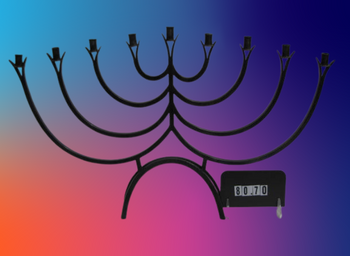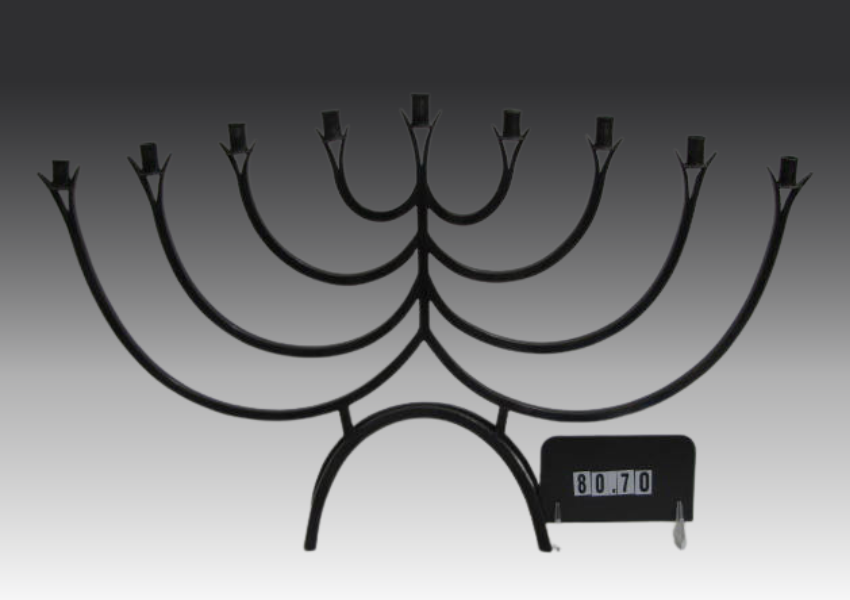A Hanukkah Lamp between Modernism and Migration
Published Dec 22, 2022

A Hanukkah Lamp between Modernism and Migration

This Hanukkah lamp was designed in San Francisco by Victor Ries (1907-2013). Ries, a sculptor and metal craftsman, was born in Berlin, Germany and had studied at the Charlottenburg School of Art before moving to Palestine in 1933, after the rise of the Nazi regime. In Tel Aviv, Ries joined the Friedlander Judaica factory for metalwork, established by Bernard (Dov) Friedlander (1881-1941), a Polish silversmith trained in Łódź, Warsaw, Odessa, Tbilisi, and Berlin. There, he met Ludwig Yehuda Wolpert (1900-1981), an influential modernist designer of Jewish ritual objects, and also began collaborating with Erich Mendelsohn (1887-1953), an influential German Jewish architect who had been ousted by the Nazis. After teaching at the Bezalel School of Arts and Crafts in Jerusalem, he moved to San Francisco in 1947, continuing his collaboration with Mendelsohn, who had been on the faculty at the University of California, Berkeley, since 1941. Ries taught at the College of Marin and at the California College of Arts and Crafts (CCAC) in Oakland, and executed designs for churches and synagogues, and continued to exhibit his work across the Bay Area.
I am endlessly fascinated by a constant tension embodied in Hanukkah lamps. Hanukkah (Heb. חנוכה, “dedication”) points to permanence: the restoring of a house (the בית המקדש, bet ha-miqdash or the holy home) and subsequent grounding of worship and identity. And yet, Hanukkah lamps, lit in Jewish homes so that their lights are visible from the outside, or even better (as in the case of Italian lamps) to be displayed on the outside of a door, facing the street, often speak of impermanence. As objects, they are in fact the support for the lights themselves, which in turn are a representation of the most impermanent of dimensions: time (each light symbolizing an extra day in which the lost oil lamps of the Temple remained lit). Highly visible “Jewish objects” in our days, lamps used to be (and in some case still are) ready-made for each Hanukkah. The one designed by Victor Ries was the work of a three-times displaced artist, a man who embodied precious and tenuous artistic links between Jerusalem and California.
Above:
Hanukkah lamp
Victor Ries (b. Viktor Shlomo Ries; Berlin, Germany, 1907 – United States, 2013)
San Francisco, California, 1980
Brass and bronze
Dimensions: 13″ x 21.75″ x 3.125″
Gift of the artist, The Magnes Collection of Jewish Art and Life, UC Berkeley, 80.70
Francesco Spagnolo is the Curator of The Magnes Collection of Jewish Art and Life and an Associate Adjunct Professor in the Department of Music at the University of California, Berkeley. A multidisciplinary scholar focusing on Jewish studies, music, and digital media, he intersects textual, visual, and musical cultur...
Reflections
For those looking at Hanukkah lamps:
What are you really seeing when you look at a Hanukkah lamp? Which lamp? Its eight branches stand in for the eight days during which the seven-branched lamps of the Temple stayed on, and only the ninth one is the "real" lamp… Which story? That of Hanukkah, that of the Temple, or that of the prophet who "saw" it first, with seven branches and oil flowing into it, but who still asked: “What do those things mean, my lord?” (Zecharaiah, 4:1-4)?
For those thinking that Hanukkah lamps are all the same:
Well, they are not! They can have different shapes, they can operate with different types of combustion, and they can have so many different cultural and political meanings, because they prompt more questions than they answer.
Want more?
Get curated JewishArts.org content in your inbox


